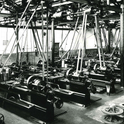Once, standing in the weaving shed at Queen Street Mill in Burnley, Lancashire, I listened as an employee turned on the steam engine, setting loose the sound of 300 dobby looms. They moved at a canter, these vast machines. Each loom running at 180 picks a minute, the wooden shuttle leaping from one side of the device to the other. It was the biggest thing I had ever heard, and when the engine stopped and the room fell still, I did not know what to do with all of the silence.
I thought about that mill again with the news that Britain’s last two blast furnaces were under threat of closure. Steel manufacturing has been in existence in Scunthorpe for some 135 years, and ironstone was mined in the area as far back as Roman times. The Scunthorpe Steelworks employs 2,700, and it is not hard to extrapolate from that number the devastation to a community should its industrial heart close: the loss of income; the trickle-down effect for local businesses; the inevitable population decline as workers migrate elsewhere.
Amid economic depredation, it might seem trite to wonder at the cultural impact of such industrial loss; how the closure of a blast furnace, a steelworks, a cotton mill, a mine, might inflict more subtle injury to regional and national identity. And yet, deindustrialisation brings an end to the rhythms and language of labour—to the culture that surrounds it, the art and the music and the literature it generates, even indirectly.
This is not to say that its impact will not continue to be felt. Several years ago, a study of British regional tastes found that in those areas of the country that were industrialised first, residents still favour music with more beats per minute than elsewhere—as if the memory of the dobby mill, the flying shuttle, the spinning Jenny might echo on through a community.
I grew up in a part of northwest England once famed for cotton and coal mining, and it has long fascinated me that certain forms of music should flourish in this former industrial hive—Northern Soul, for instance, with its long nights of particularly energetic dancing, or Donk, the genre of dance music characterised by an offbeat bassline that sounds synthetic, manufactured.
In my childhood, the mills stood derelict and the mines long closed; out towards the coast, the dockers were striking. My mother used to tell me of the days she worked in the employment exchange just as those mills were emptying, when she would try to find new jobs for workers, half-deaf from the roar of machinery, still speaking in the exaggerated mee-maw once used to communicate across the mill floor.
Later, the region, like much of the North, was re-thought: vast shopping centres and retail parks built, and those same empty mills refashioned as luxury apartments. It brought a strange sense of disconnection; a long-standing manufacturing community now encouraged to regenerate through consumerism, as if the region had been left to mee-maw only with its past.
‘Machine has eaten up my job, my meaning, my cause,’ sings Lisa O’Neill
Many musicians have protested about this industrial devastation, from Billy Bragg to Sleaford Mods via Richard Dawson and the Flying Pickets. In 2018, the Irish singer Lisa O’Neill released the particularly devastating “Rock the Machine”, a song that mourned the mechanisation of work in Dublin harbour. Sung from the perspective of a coal-shoveller on the dock, it voiced a similar sense of disorientation at the changes the modern world had brought: “My hands are soft cotton gloves,” it ran. “Machine has eaten up my job / My meaning, my cause.”
Its verses carried a leadenness and a pang, O’Neill singing flatly over drone and an automated banjo rhythm. When she reached her chorus, strings soared and her voice lifted and found light as she likened the sense of purpose and belonging the docker found working on the river to that of a heron or a cormorant diving into the Liffey. Industry, place, music and identity became persuasively bound.
The UK recently dropped out of the top 10 manufacturing nations for the first time, and today it is responsible for just 0.3 per cent of global steel output. It is possible, perhaps, that these sectors might rise again. Or that this nation will come to find new industries and, with them, the new rhythms and language of their labour: the sound of distribution centre, wind turbine, biotechnology; of a country finding a different identity and a different music.












